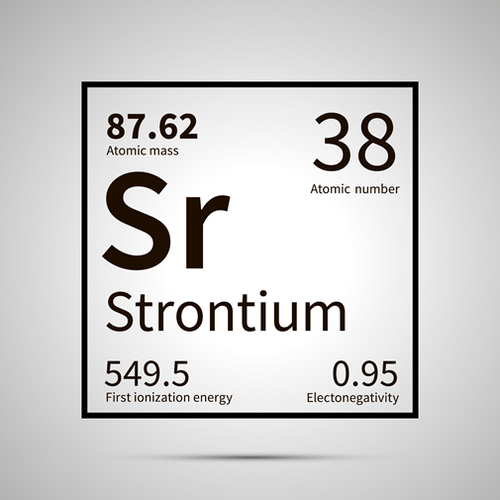
Background
Strontium is physically and chemically similar to calcium. Most strontium in the body comes from drinking water and food. Several different forms of strontium are used as medicine. Strontium chloride is the most common form found in dietary supplements.
People use strontium for tooth sensitivity, cancer that has spread to the bones, osteoporosis, osteoarthritis, and prostate cancer. It is also used for dental cavities, fractures, and other conditions, but there is no good scientific evidence to support these other uses.
Safety Safety definitions
Taking very high doses of strontium is possibly unsafe. Doses of elemental strontium above 680 mg daily might damage the bones.
There isn't enough reliable information to know if the form of strontium typically used in dietary supplements (strontium chloride) is safe or what the side effects might be.
When applied to the teeth: Toothpastes (Sensodyne-SC) that contain strontium are likely safe. Sensodyne-SC is an FDA-approved product.
Special Precautions & Warnings:
Pregnancy and breast-feeding: Strontium is likely safe when consumed in foods or used in a toothpaste (Sensodyne-SC) while pregnant or breast-feeding. There isn't enough reliable information to know if taking strontium by mouth in larger amounts is safe when pregnant or breast-feeding. Stay on the safe side and stick to food amounts.Heart disease: Don't use strontium if you have high blood pressure or heart disease.
Cerebrovascular disease (stroke): Don't use strontium if you have a history of stroke or poor circulation to the brain.
Kidney problems: Strontium is eliminated by the kidneys and can build up in people with poor kidney function. Use strontium supplements with caution if you have kidney disease. Strontium ranelate should not be used if kidney disease is advanced.
Paget's disease (a bone disease): Use strontium with caution. The bones of people with Paget's disease seem to take up more strontium than normal. It's not clear if this is a concern.
Peripheral arterial disease (decreased blood flow through veins): Don't use strontium if you have peripheral arterial disease.
Blood clotting disorders: Strontium ranelate is associated with a small increased risk of blood clots. Strontium might be more likely to cause blot clots in people with blood clotting disorders or those at high risk of blood clotting. Avoid strontium if you have a clotting disorder.
Effectiveness
- Tooth sensitivity. Brushing with strontium-containing toothpaste helps reduce tooth sensitivity.
- Cancer that has spread to bone and causes pain. A special prescription form of strontium (strontium-89 chloride) given by IV reduces pain from metastatic bone cancer. IV products can only be given by a healthcare provider.
- Weak and brittle bones (osteoporosis). Taking strontium ranelate by mouth reduces the risk of fractures and increases bone density in people with osteoporosis. But it can cause serious side effects, so other treatments are usually used instead. Strontium ranelate is not available in the US.
- Osteoarthritis. Taking strontium ranelate by mouth helps prevent arthritis of the spine from becoming worse. It also seems to decrease pain, stiffness, and loss of cartilage in people with arthritis of the knee. Strontium ranelate is not available in the US.
- Prostate cancer. Giving a special prescription form of strontium (strontium-89 chloride) by IV slows the growth of prostate cancer. IV products can only be given by a healthcare provider.
Dosing & administration
Interactions with pharmaceuticals
Antacids
Interaction Rating=Moderate Be cautious with this combination.
Antacids can decrease how much strontium the body absorbs. To avoid this interaction, take antacids at least two hours after taking strontium products.
Antibiotics (Quinolone antibiotics)
Interaction Rating=Moderate Be cautious with this combination.
Strontium can attach to some antibiotics called quinolones in the stomach. This decreases the amount of quinolones that can be absorbed. Taking strontium with quinolones might decrease their effectiveness. To avoid this interaction, take strontium at least 2 hours before or after taking quinolones.
Antibiotics (Tetracycline antibiotics)
Interaction Rating=Moderate Be cautious with this combination.
Strontium can attach to some antibiotics called tetracyclines in the stomach. This decreases the amount of tetracyclines that can be absorbed. Taking strontium with tetracyclines can decrease their effects. To avoid this interaction, take strontium at least 2 hours before or after taking tetracyclines.
Estrogens
Interaction Rating=Moderate Be cautious with this combination.
Estrogens might decrease how fast the body gets rid of strontium. This could cause the body to have too much strontium and potentially cause side effects.
Male hormones (Androgens)
Interaction Rating=Moderate Be cautious with this combination.
Male hormones might decrease how fast the body gets rid of strontium. This could cause the body to have too much strontium and potentially cause side effects.
Interactions with herbs & supplements
Bladderwrack: Bladderwrack, also known as kelp, contains alginate which binds strontium and reduces its absorption. This effect has been used to reduce strontium absorption in cases of poisoning, but could also affect the absorption of strontium supplements.
Calcium: Calcium reduces the absorption of strontium. Strontium ranelate should be taken at least 2 hours before or after calcium supplements. Strontium can also reduce calcium absorption from the stomach.
Laminaria: Laminaria contains alginate which binds strontium and reduces its absorption. This effect has been used to reduce strontium absorption in cases of poisoning, but could also affect the absorption of strontium supplements.
Vitamin D: Vitamin D might increase the absorption of strontium, possibly increasing its effects and side effects.


